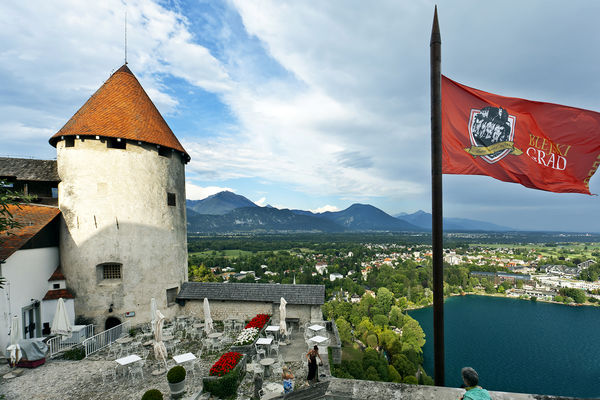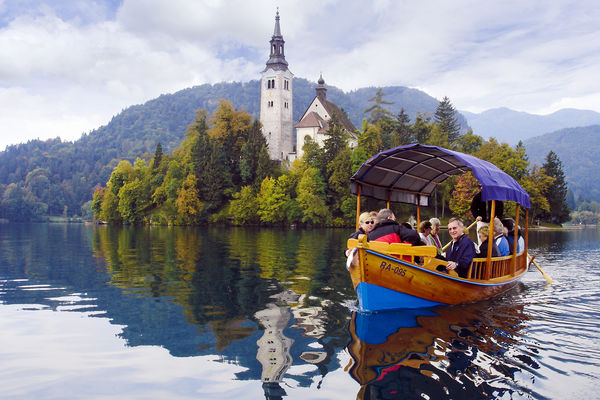Lake Bled: Exploring Slovenia’s Romantic Alpine Retreat
By Rick Steves

Tiny Slovenia, nestled where the Alps meet the Adriatic Sea, is one of Europe's most unexpectedly charming destinations, with spectacular natural beauty and a fascinating recent history — yet much of it is still far off many tourists' path. One of its brightest gems is a romantic getaway that once entertained emperors and presidents: Lake Bled.
Nestled up against the northeast side of the rugged Julian Alps, just south of the Austrian border, Lake Bled is almost certainly the most photogenic, relaxing spot in Slovenia (and that's saying a lot). The picture-perfect lake laps up against a tiny church-topped island, sheer cliffs that lead to an improbably perched medieval castle, and the bare feet of toe-dipping vacationers. Since the Habsburg days, this has been where Slovenes take their guests — whether kings or cousins — to show off their nation's natural wonders.
The four-mile path that rings the lake is an understandably popular route for a stroll. At a leisurely pace, the path takes about an hour and a half on foot, but I'd allow more for snapping photos of the ever-changing views. While walking the lakeside is slo-mo bliss, biking lets you fast-forward through the scenery. Either way, you'll pass several grand villas, most of them built by local aristocrats in the early 19th century. The most noteworthy is the former residence of Yugoslav president-for-life Marshal Tito — today the Hotel Vila Bled, a fine place to stop for a coffee and pretend that Tito has invited you to drop by.
No visit to Lake Bled is complete without a trip to its steeple-capped island, which nudges the lake's quaintness level over the top. The most romantic route to the island is on one of the lake's unique flat-bottomed pletna boats. Like the equally distinctive gondolas of Venice, these boats carry on a tradition dating back generations. Locals still build their pletnas by hand with larch wood from a design passed down from father to son for centuries. Since the boats have no keel, the skilled oarsmen must work hard to steer them with each stroke. Watching them row is a special experience — but a pletna ride is expensive, and the oarsmen stick close to their 30-minute waiting time on the island. Fortunately, you can rent a simple wooden rowboat for much less money (and enjoy the pletna boats from the outside).
The pretty Church of the Assumption, atop the tiny island's summit, stands on the site of an eighth-century Slavic pagan temple. It's a popular spot for weddings — even though tradition dictates that grooms carry their bride up the 99 steps leading from the boat dock up to the church door. According to local superstition, ringing the church bell three times with one big pull on the rope — which hangs right down to the altar — will grant you a wish. I can't promise that it works, but each I time tug the rope and make a wish, I open my eyes to find myself on an enchanting island in the middle of a stunning lake.
If you have at least a few hours to spend here, you could follow one of the hiking paths lead up into the hills surrounding the lake. From these hills you can peer not just down into the lake, but up to the surrounding Julian Alps, which are crowned by the triple peaks of Mount Triglav: Slovenia's highest point and national symbol. And the big mountain behind the town of Bled, called Stol ("Chair"), is part of the Karavanke range that defines the Austrian border. Bled is a great jumping-off point for scenic mountain drives, and other worthwhile side-trips, such as the more rugged region around Lake Bohinj.
Even on a short visit, I'd make the short hike up to Bled Castle for a little bit of history and lots of big views. Dating in one form or another from about 1,000 years ago, it had been the seat of the Austrian bishops who controlled Bled in the Middle Ages. The various sights at the castle — a decent history museum, frescoed chapel, old-fashioned printing press, and wine cellar — are cute, but the real reason to come up here is to bask in the sweeping panoramas.
No matter what, be sure to try the town's sweet specialty, a cream cake called kremna rezina: a layer of cream and a thick layer of vanilla custard artfully sandwiched between sheets of delicate, crispy crust. For many Slovenes, the chance to sample this famous dessert is reason enough to visit Bled. And grmada ("bonfire") is a deliciously messy dessert invented by a local hotel as a way to use up their leftovers. They took yesterday's cake, added rum, milk, custard, and raisins, and topped it off with whipped cream and chocolate syrup…and stumbled upon genius.
Dessert in hand, sit on a dock, dip your feet in the water, and watch the lake's resident swans. It's the perfect end to a perfectly relaxing day in one of Slovenia's most scenic alpine retreats.

